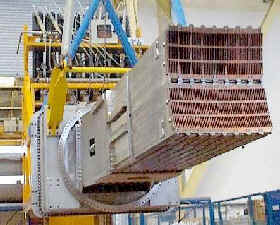|
4) - Heating and
current generation
(p 1
- 2 - 3 - 4
-
5 - 6 - 7 )
| Hybrid frequency heating: the champion of current generation |
c) heating by radio-frequency wave
By increasing the frequency, we reach the domain of
the lower hybrid frequency, which uses a so-called slow wave
 of few GHz (corresponding to centimetre wavelengths, which thus are
short compared to the plasma dimensions. The first use of this wave was to get into the conditions where the wave encounters the lower hybrid resonance in its journey through the plasma. This hybrid heating has turned out to be rather inefficient and is no longer used on
present tokamaks.
of few GHz (corresponding to centimetre wavelengths, which thus are
short compared to the plasma dimensions. The first use of this wave was to get into the conditions where the wave encounters the lower hybrid resonance in its journey through the plasma. This hybrid heating has turned out to be rather inefficient and is no longer used on
present tokamaks.
On the other hand, the lower hybrid wave has a strong electric field
 parallel to the magnetic field, making it a good candidate to accelerate electrons
in the toroidal direction by Landau absorption. We therefore use it in current generation mode, by
phasing between the different waveguides going into the tokamak, so as to generate a wave with a dissymmetrical toroidal spectrum. The wave couples
to the parallel movement of the electrons, more particularly of the very energetic electrons naturally present in a very small amount in the
discharge. These supra-thermal electrons absorb it powerfully (so powerfully that the wave sometimes has trouble reaching the
plasma core). The wave thus tends to develop this supra-thermal population : watch out for damage to plasma facing components, if it is not properly controlled. In addition, even if it is not absorbed too quickly, this type of wave has difficulty in propagating within plasmas that are very dense and hot. For these reasons, the hybrid wave is a good candidate for current
generation in the peripheral region of reactor type plasmas. On the other hand, because of the direct and intense absorption
by electrons, current generation efficiency (i.e. the quantity of current created per unit of power) of the hybrid wave is among the best. parallel to the magnetic field, making it a good candidate to accelerate electrons
in the toroidal direction by Landau absorption. We therefore use it in current generation mode, by
phasing between the different waveguides going into the tokamak, so as to generate a wave with a dissymmetrical toroidal spectrum. The wave couples
to the parallel movement of the electrons, more particularly of the very energetic electrons naturally present in a very small amount in the
discharge. These supra-thermal electrons absorb it powerfully (so powerfully that the wave sometimes has trouble reaching the
plasma core). The wave thus tends to develop this supra-thermal population : watch out for damage to plasma facing components, if it is not properly controlled. In addition, even if it is not absorbed too quickly, this type of wave has difficulty in propagating within plasmas that are very dense and hot. For these reasons, the hybrid wave is a good candidate for current
generation in the peripheral region of reactor type plasmas. On the other hand, because of the direct and intense absorption
by electrons, current generation efficiency (i.e. the quantity of current created per unit of power) of the hybrid wave is among the best.
| We see here a hybrid antenna (often called a grill) being handled before installation in Tore Supra. |

|
On Tore Supra, this heating system is extensively
used for the non-inductive generation of current in the framework of the long
duration discharge programme. It was with 2.3 MW hybrid
power injected for 2 minutes into the machine that Tore Supra came to hold the world energy record of 280 MJ .As always, the crucial point is to ensure proper coupling of the wave to the plasma. In contrast to the FCI system, which needs operation above a critical density, the hybrid system is
more efficient in generating current at low density.
|
In addition, hybrid heating is used to go into enhanced confinement mode, LHEP (or Lower Hybrid Enhanced
Performance) by shaping the current profile j inside the plasma. The current generated by the hybrid (in green here), located at half radius of the tokamak, comes in addition to the normal current, going from the current profile in blue of the L mode to that in red of the LHEP mode. The peak in current provokes an effect on the transport of particles and energy, as is seen on the heat transport coefficient
ce, which collapses in the
plasma centre in LHEP mode (in red) although it is relatively constant in L mode (in blue). This corresponds to a transport barrier, and enhanced confinement.
|

|
|
|